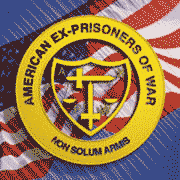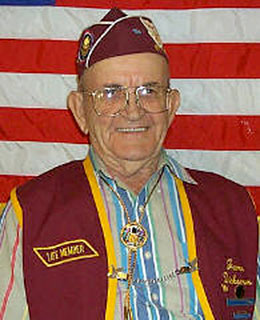
Established April 14, 1942
 |
American Ex-Prisoners of War
A not-for-profit, Congressionally-chartered veterans’ service organization advocating for former prisoners of war and their families.
Established April 14, 1942 |


James J. Dickerson, Baton Rouge Nat. Convention 1998
|
||
| Last Name | First Name, Middle Init. | Nickname |
| Spouse | City | State, Zip |
| Conflict — Theatre | Branch of Service | Unit: |
| Military Job | Date Captured | Where Captured |
| Age at Capture | Time Interned | Camps |
| Date Liberated | Medals Received | |
| After the War ... | ||
At the end of March, 1944, the army closed down the ASTP programs throughout the country, and most of us at Auburn were shipped to Camp Atterbury, Indiana, where we joined the 106th Infantry Division and received training for combat during the following months. My 423rd Infantry Regiment was shipped to Europe aboard the Queen Elizabeth I, sailing from New York on October 17, 1944. We were housed in Britain for several weeks just outside Cheltenham, Gloucestershire, until shipped to France at the end of November. We arrived at the front, in the Siegfried Line just inside Germany, on Monday, December 11, 1944, five days before the Germans launched the Battle of the Bulge against us. Ordered to evacuate our position and go to a rendezvous point near Schonberg, Belgium, we reached our destination but were not "rescued" as planned. Our Regimental Commander surrendered the remnant of his regiment on Tuesday afternoon, December 19, 1944, to save us from death by German artillery fire.
Processed as a POW by the Germans at Stalag IVB, Muhlberg, I was sent as part of an Arbeitskommando of 150 men to Dresden on January 12, 1945 where we were billeted in Building Number Five of the Dresden Slaughter-House Compound, later made famous by Kurt Vonnegut's classic novel which was based on our common experiences. After the firebombing of Dresden, we were moved by our guards to the suburb of Gorbitz, and in mid-April, our guards marched us to the hamlet of Hellendorf on the Czech border, some 35 miles or so SE of Dresden. There we awaited the end of the war and the arrival of the Russians in whose zone of occupation we found ourselves. I returned to the US Army control on Mother's Day, May 13, 1945, and was given an honorable discharge from the army at Fort Bragg, NC, on November 25, 1945.
After the war I returned to college, graduated from Cornell in 1948, and then began graduate study in the history of modern Europe at Harvard. I received the M.A. degree in 1949 and the Ph.D. in 1966, having in the interim taught for three years at The American University of Beirut, Lebanon, 1952-1955, and subsequently at Ohio University, beginning in 1958.
I married Mary Letitia Cowan, a faculty colleague at Ohio U. on June 9, 1964, and we both continued our teaching careers at Ohio in the city of Athens. Mary had done a year of post-graduate study in textiles at Leeds University, Yorkshire, England, and her field of specialization thereafter was textiles in the Ohio University School of Home Economics. She retired officially in 1982 but continued teaching part time until 1989. I took early retirement in 1993 and retired fully one year later. The University honored Mary at her retirement by naming the assemblage of textiles and clothing the "Mary C. Doxsee Costume Collection."
My service to Ohio University included chairing the Energy Conservation Committee in the 1970's and directing the graduate program in African Studies from 1983 to 1991. Our travels included numerous trips to Europe as well as professional travel to the Middle East and North Africa, the focus of my later teaching. Since retiring, I have served as adjutant/treasurer of the Mid-Ohio Valley Chapter, American Ex-Prisoners of War since 1996, as as JVC of the Department of Ohio since 1998.